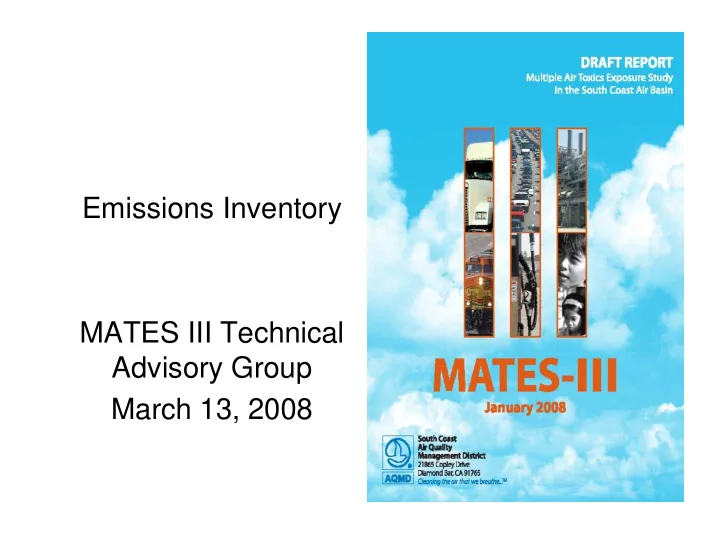

Emissions Inventory MATES III Technical Advisory Group March 13, 2008
Outline • Methods • Results for carcinogens � Species apportionment � Source apportionment � Emissions and air quality changes since MATES-II
Methods • 2007 AQMP inventory forms the basis of the MATES-III toxic inventory. • 2002 baseline emissions projected to 2005. • “Top-down” approach used for developing toxic emissions. – i.e., chemical composition of TOG and PM emissions determined by ARB’s speciation profiles. – http://www.arb.ca.gov/ei/speciate/speciate.htm. • Emissions spatially allocated to 2 km by 2 km grid cells.
Why “Top-down Approach? • Speciating TOG and PM inventories affords consistency with 2007 AQMP. – Fits in with AQMD’s goal of a comprehensive plan • Photochemical modeling requires complete speciation of TOG; an inventory of just toxics would be insufficient. • AQMP tools for projecting future emissions & air quality benefits can also be used for MATES-III to estimate cancer risk benefits from the AQMP.
Pollutants Inventoried Acetaldehyde* Elemental carbon Organic carbon Acetone Ethylene dibromide* p-Dichlorobenzene* Arsenic* Ethylene dichloride* Perchloroethylene* Benzene* Ethylene oxide* Propylene oxide* 1,3 Butadiene* Formaldehyde* Selenium Cadmium* Hexavalent chromium* Silicon Carbon tetrachloride* Lead* Styrene Chloroform* Methyl ethyl ketone Toluene Chromium Methylene chloride* Trichloroethylene* 1,1 Dichloroethane* MTBE* Vinyl chloride* Diesel particulate* Naphthalene* 1,4 Dioxane* Nickel* * denotes carcinogen
Emission Inventory Results
Preliminaries • Slides that follow only consider carcinogens. • Emissions are in diesel PM currency. – i.e., emissions weighted by the ratio of the carcinogen’s cancer potency to the cancer potency of diesel PM. • 1998 = MATES-II; 2005 = MATES-III
Species Apportionment of Cancer Potency Weighted Emissions Contribution Contribution Toxic Toxic (%) (%) Diesel particulate 86.94 Arsenic 0.66 1,3-Butadiene 4.02 p-dichlorobenzene 0.30 Benzene 2.95 Cadmium 0.29 Perchloroethylene 2.92 Hexavalent chromium 0.26 Formaldehyde 0.97 Naphthalene 0.24 Total 99.6
Carcinogenic Source Apportionment Area Point 5% 2% On-road 36% On-road Off-road Point Area Off-road 57%
Carcinogenic Emissions (MATES-II vs. MATES-III) 80,000 Source Percent Change Category Emissions as DPM (lbs/day) 60,000 On-road 13% decrease 40,000 Off-road 1% increase Point 65% decrease 20,000 Area 43% decrease 0 MATES-II (1998) MATES-III (2005) On-road Off-road Point Area
Emission and Air Quality Changes Since MATES-II Gases � E � AQ Particulates � E � AQ Acetaldehyde -9% -9% Arsenic -20% -59% Benzene -36% -50% Cadmium -19% -75% 1,3 Butadiene -31% -73% Elemental Carbon -2% -28% Formaldehyde -21% -9% Hex. Chromium -85% -5% Methylene Chloride -38% -53% Lead -14% -53% Perchloroethylene -58% -78% Nickel -22% -34% Trichloroethylene -65% -81%
Recommend
More recommend